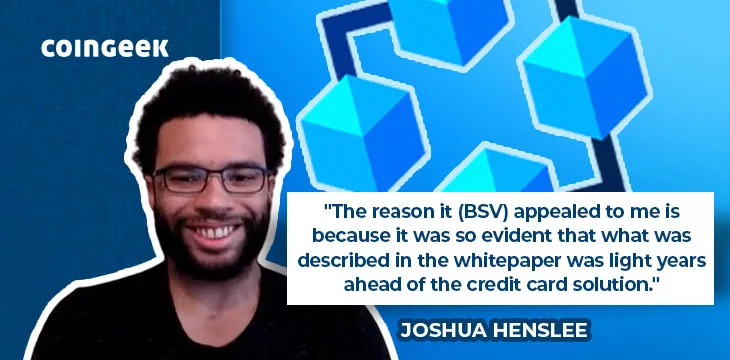|
Getting your Trinity Audio player ready...
|
Joshua Henslee recently checked in with the Cryptocurrency Theory podcast to talk to Chad Bailey about Bitcoin SV, Ordinals, and much more.
How both Henslee and Bailey got into digital currencies and blockchain technology
Henslee introduces himself as a Bitcoin maximalist and lays out his stance that the original Bitcoin had everything we needed.
Bailey asks Henslee for his Bitcoin story, what initially attracted him to the technology, and why it’s important to him. Henslee tells his host about his background in integrating business software and payment systems and credit card processors. He tells viewers how this is a technical nightmare and is very inefficient.
When Bitcoin ran up in 2017, Henslee began to pay attention. He read the white paper and instantly got it. Since then, he’s been tumbling down the Bitcoin rabbit hole.
Bailey relates to this, saying he fell in love with it immediately. He says he’s still amazed at how few people understand the technology, including people working in or studying computer science, who you’d expect to be up to date on cutting-edge technology. He then asks Henslee, “why Bitcoin SV?”
Why Bitcoin SV?
Henslee begins by giving some context. The reason he was interested in Bitcoin in the first place is because he knew it was light years ahead of the credit card processing solutions he worked with every day. He reminds us that Satoshi made it clear that peer-to-peer transactions with no trusted third parties are the way Bitcoin transactions are meant to occur. This is the polar opposite of how credit cards work, which is the reason for their problems.
After small blockers caused Bitcoin fees to increase exponentially compared to what they were in the early days, Henslee began looking into Ethereum, Litecoin, BCH, and other blockchains. He eventually consolidated into BCH, and when an argument broke out in that camp, he landed on the BSV side.
“What Satoshi designed is nothing like what BTC is today,” Henslee tells the audience. He explains how Bitcoin script allowed smart contracts on the blockchain; there was no block size limit, it scaled and had low fees, etc. “Ethereum only exists because the Bitcoin Core developers disabled the script,” he tells Bailey, remembering how BTC Core developers chased Vitalik Buterin off and told him what he wanted to build wasn’t allowed.
Bailey takes a moment to remind his viewers, many of whom are new to digital currencies, that BCH and BSV are far from down and out. He reminds us that they had a huge impact on the entire ecosystem when the forks happened, and just the other day, BSV shot up 30% on massively increased volume.
A huge BSV price pump back in 2020
Bailey directs viewers to Henslee’s video analyzing the historical BSV price. He asks Henslee to explain more about these events and what caused them.
Henslee answers that two come to mind. The first came after the CoinGeek Toronto Conference in May 2019, and the other was caused by a false rumor coming out of China that Dr. Craig Wright had publicly signed with Satoshi Nakamoto’s keys; this caused BSV to rise rapidly against other digital currencies and independently of them.
On this second pump, BSV moved into the top five coins by market cap and surpassed BCH for the first and only time so far. BTC maximalists melted down, sensing the threat of miners switching to the BSV chain, and moved to attack BSV.
Henslee says he once again noticed BSV and BCH moving independently of the rest of the market last week. This is because of concerns about whether Ordinals will cause a BTC chain split or will cause the BTC blockchain to fail. He says this could happen faster than people expect.
“BSV only has to get to around 5% of BTC to start causing problems,” he tells viewers.
Ordinals, JPEGs, and bigger BTC blocks
Bailey asks Henslee to explain how a 4MB block on BTC was possible and what Ordinals are all about.
Henslee explains that Ordinals are possible because of specific changes BTC Core developers made to Satoshi’s original design, SegWit and Taproot. An independent developer found a way to put data on the blockchain even though BTC Core had explicitly blocked this.
“The whole crypto market was under the impression that you can’t do data on BTC. That changed in January 2023,” he says.
Henslee describes the innovation and activity on BTC since Casey Rodarmor found the loophole as “a renaissance.” He delves into non-fungible tokens (NFTs) and fungible tokens (BRC-20), explaining how swapping BTC for tokens like $ORDI on the BTC blockchain is possible. The returns on this particular token so far have been absurd, proving the market has responded positively to these developments. Henslee once again iterates his position that this is a game changer.
Mining on BSV
Bailey wraps up by asking Henslee if he thinks BSV only having two miners could be a problem.
Henslee explains that there’s no real incentive to mine BSV in the wider ecosystem; the coin price is low, and the fees are so small that they barely register. This does open the chain up to potential attacks, and there have been attacks such as the empty block miner in 2022.
The only way to fix this is a higher coin price or more transactions, Henslee says. He notes that transaction fees could increase, but that debate has already happened in BSV, and the fees remain low.
Understanding the Bitcoin Whitepaper | Section One: The Introduction

 06-01-2025
06-01-2025 





